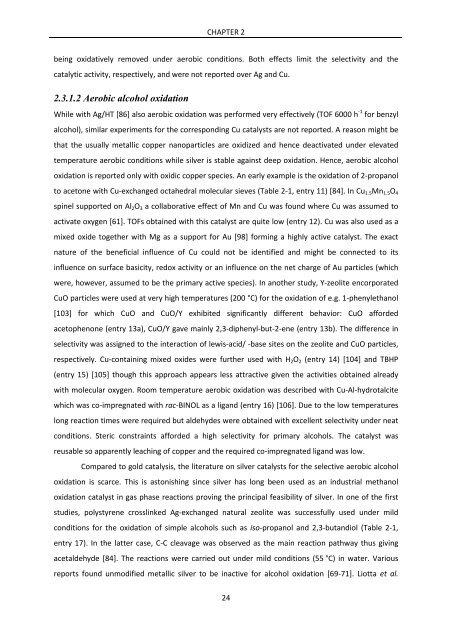Heterogeneously Catalyzed Oxidation Reactions Using ... - CHEC
Heterogeneously Catalyzed Oxidation Reactions Using ... - CHEC
Heterogeneously Catalyzed Oxidation Reactions Using ... - CHEC
You also want an ePaper? Increase the reach of your titles
YUMPU automatically turns print PDFs into web optimized ePapers that Google loves.
CHAPTER 2<br />
being oxidatively removed under aerobic conditions. Both effects limit the selectivity and the<br />
catalytic activity, respectively, and were not reported over Ag and Cu.<br />
2.3.1.2 Aerobic alcohol oxidation<br />
While with Ag/HT [86] also aerobic oxidation was performed very effectively (TOF 6000 h ‐1 for benzyl<br />
alcohol), similar experiments for the corresponding Cu catalysts are not reported. A reason might be<br />
that the usually metallic copper nanoparticles are oxidized and hence deactivated under elevated<br />
temperature aerobic conditions while silver is stable against deep oxidation. Hence, aerobic alcohol<br />
oxidation is reported only with oxidic copper species. An early example is the oxidation of 2‐propanol<br />
to acetone with Cu‐exchanged octahedral molecular sieves (Table 2‐1, entry 11) [84]. In Cu1.5Mn1.5O4<br />
spinel supported on Al2O3 a collaborative effect of Mn and Cu was found where Cu was assumed to<br />
activate oxygen [61]. TOFs obtained with this catalyst are quite low (entry 12). Cu was also used as a<br />
mixed oxide together with Mg as a support for Au [98] forming a highly active catalyst. The exact<br />
nature of the beneficial influence of Cu could not be identified and might be connected to its<br />
influence on surface basicity, redox activity or an influence on the net charge of Au particles (which<br />
were, however, assumed to be the primary active species). In another study, Y‐zeolite encorporated<br />
CuO particles were used at very high temperatures (200 °C) for the oxidation of e.g. 1‐phenylethanol<br />
[103] for which CuO and CuO/Y exhibited significantly different behavior: CuO afforded<br />
acetophenone (entry 13a), CuO/Y gave mainly 2,3‐diphenyl‐but‐2‐ene (entry 13b). The difference in<br />
selectivity was assigned to the interaction of lewis‐acid/ ‐base sites on the zeolite and CuO particles,<br />
respectively. Cu‐containing mixed oxides were further used with H2O2 (entry 14) [104] and TBHP<br />
(entry 15) [105] though this approach appears less attractive given the activities obtained already<br />
with molecular oxygen. Room temperature aerobic oxidation was described with Cu‐Al‐hydrotalcite<br />
which was co‐impregnated with rac‐BINOL as a ligand (entry 16) [106]. Due to the low temperatures<br />
long reaction times were required but aldehydes were obtained with excellent selectivity under neat<br />
conditions. Steric constraints afforded a high selectivity for primary alcohols. The catalyst was<br />
reusable so apparently leaching of copper and the required co‐impregnated ligand was low.<br />
Compared to gold catalysis, the literature on silver catalysts for the selective aerobic alcohol<br />
oxidation is scarce. This is astonishing since silver has long been used as an industrial methanol<br />
oxidation catalyst in gas phase reactions proving the principal feasibility of silver. In one of the first<br />
studies, polystyrene crosslinked Ag‐exchanged natural zeolite was successfully used under mild<br />
conditions for the oxidation of simple alcohols such as iso‐propanol and 2,3‐butandiol (Table 2‐1,<br />
entry 17). In the latter case, C‐C cleavage was observed as the main reaction pathway thus giving<br />
acetaldehyde [84]. The reactions were carried out under mild conditions (55 °C) in water. Various<br />
reports found unmodified metallic silver to be inactive for alcohol oxidation [69‐71]. Liotta et al.<br />
24



